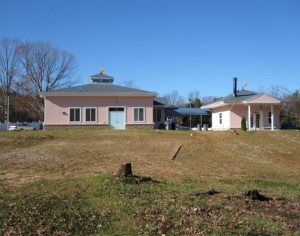2008 was the year for planning, designing, budgeting and finally getting ready for of the Temple construction. While we started-off with several ideas to start a small about 1,000 to 1,200 sq.ft, simple modular structure, we have finally settled on a 2,000 sq.ft facility, using wooden structure, with ample space (though, in reality it proved to be too small within the first month of opening the facility) for main altar & worship area, and including an office room, priest room, and a small kitchen. Lots of ground work was done related to the layout and architecture of the building, and getting approvals from the County of Goochland to build the temple.
A building architect and a civil engineer are engaged to complete the site survey and layout design. At the same time efforts were put into obtaining required permits for building the temple. Upon obtaining the permits, civil contractor engaged to develop the site and also to build yagna kundams, parking lots and inside roads. During this period, several obstacles surfaced, including shortage of funds, which hampered the project progress.
During this crisis period, all people involved did intense prayers and did Sai Satcharitra parayanam, and then sought help from Guruji. In his immense grace, Guruji agreed to come to US again and help us out. On June 29th & 30th, 2008 Guruji performed Ganapathi Tantram at our site for removing all obstacles and for quick progress, and a Maha Yagnam. During this Yagnam, Sri Guruji named this temple “Sri Sai Amrutha Narayana Sarveshwaralayam”.
 Soorpa Karna Ganapathi yantram fully lit.(June 2008) |
 Guruji offering Poornahuti during yagnam(June 2008) |
 Above: Ganapathi Tantram in progress. (The Ganapathi tantram and the yagna performed by Guruji helped in removing all the obstacles and project progressed briskly then onwards.)
Above: Ganapathi Tantram in progress. (The Ganapathi tantram and the yagna performed by Guruji helped in removing all the obstacles and project progressed briskly then onwards.)
Also, on August 31st, 2008, on the occasion of birthday of Guruji, the third Prayoga yagnam was performed on site by Pandit Sri B. Rajagopalan, for speedy completion of temple construction. With all these efforts, site development works completed for starting the building work and around by end of September we were able to select a building contractor to start the construction, with a total budget of ~ 850,000. To save money all the building electrical works were directly managed by volunteers instead of keeping it in scope of building contractors.
Phase-I completes in Jan 2009. On February 5th, 2009, the Temple formally opened its door to the devotees on the auspicious Ratha Sapthami day.
Our Vigrahams:
Sri Sai Amrutha Narayana Vigraham, along with all other idols in the temple, were sculpted in Tirumurugan Poondi near Coimbatore in Tamil Nadu.
All our vigrahams are custom designed per requirements from Guruji and are beautifully sculpted by gifted sculptors. In case of Sai Amrutha Narayana idol, the sculptor had never made an idol of Baba before, but this was his first attempt. He made two attempts but somehow couldn’t get Baba’s face looking right. Then Mama suggested three things. One, surrender to Baba. Two, visit the Sai temple in Coimbatore. And three, read the Shirdi Sai Satcharitam in seven days. This man, however, was illiterate. So, a relative of Mama’s who lived nearby began visiting him for a whole week and read the Satcharitam aloud to him. He went to work at the end of the parayanam and in seven days he had this beautiful moorthy that he was able to create all through Baba’s divine grace. Baba’s vigrahams came to us, just 3 days before Kumbabhishekam!
In April 2009, Baba’s marble idol came to the site on Ram Navami unexpectedly! After years of being ignored and stored at the back of a garage, this moorthy was brought here to our temple. Plans were changed immediately to construct a Dhuni Mandir, within 7 weeks, in time for the Kumbabishekam, to accommodate the new statue along with Runavimochana Ganapathi and Hanuman. The phase I of the temple, included installation of Sri Sai Amrutha Narayana, Sri Shirdi Sai, Maha Ganapati, Runavimochana Ganapati, Mruthyunjaya Bhairava, Nava Grahas, Subramanyeswara Swami with Valli and Devayani, Nandi, Mushika and Bali peetams.
With the grace of Baba phase I construction was fully completed by end of June 2009, and Vigraha Mantra, Thantra, Yantra Prana Pratishta, the fourth Yagnam, and Kumbabhishekam, was performed by Guruji and Mama from July 2nd 2009 through July 6th 2009.
Key features of the temple (at the end of Phase I):
- This is the first temple built primarily based on Prayoga Shastra in modern times. Prayoga Shastra is a part of Chaaya Atharvana Veda.
- Temple Design is based on “Dhanvantri” concept, to bestow good health and prosperity to all devotees, and its design and layout is based on ‘Prayoga’ Shastra.
- Sri Sai Amrutha Narayana idol – This temple is unique in that it would have the main Baba idol made from Blackstone. This is very rare and unique concept – it is the first in the US and probably only the 3rd or 4th in the world. It was specifically done in black stone so that more and more abhishekams can be done for the welfare and good health of everyone.
- Navagrahas – The Navagrahas have their consorts along with them which is quite rare and can only be seen in few temples. We strongly believe that having the Mother there, will help grant your wishes sooner.
- Holy Pond – The site has a naturally formed pond in the North East direction of the temple (similar to Purna Pushkarini in Tirupathi) which is considered divine
Above: View of the temple main altar after installation of Sri Sai Amrutha Narayana and other Bhagavan vigrahams – 2009
Phase II of the development started in the year 2012 and ……(to be continued)







